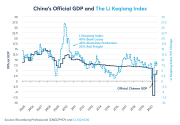^^
Lol, where did you find this graph? I've been looking for it for the last 30 min and find 0. I've seen it once before, so I wanted to answer to post.
The idea of China's real growth being 2-3% came about a few years ago. It's based on Li Keqiang's index of using electricity/coal consumption, steel production, and rail volume as a measurement of economic health. A few China observers took this index to imply the overall economic growth was around 3%. As we all know China made a big shift towards tertiary sectors and high tech that consumes less physical resources for each GDP dollar produced.
Using this index as a measure of GDP growth reflects an outdated view of China's economic structure.
Actually, it was years before, about 2015, when Li Keqiang Index was lower than the official GDP, now it's higher like on the graph above my post.
But I want to clarify, Pettis assumption here is that Chinese GDP "real" growth will be 2-3% for years to come when China stops pumping GDP with debt. (deleveraging total debt, also unofficial debt).
He is a little right that in the case of the complete stop with total debt rising, China's GDP growth must fall, but I believe it won't be like he forecasts. For now, I see China wants to stabilize the debt to GDP %, after 2020 shot in total debt.
Pettis believes that the transition to a more consumer-based economy will take a very long time, and if we look at how the official Chinese GDP composition looks like we would also say that it would take a long time. BUT. China retail sales are the same as the USA, so we ask ourselves why the Chinese consumer economy is so much lower than America?
*Firstly, USA adds a lot of things to GDP that China does not
*Secondly, USA lawyers and health industry is huge and too expensive pumping GDP.
*Thirdly, China has a huuuge gray area, mainly where? Yes, in-services, consumer-based economy! So, the Chinese consumer market is there, it's higher than in official stats. It won't take decades to transition it to consumption as Pettis suggest, it will take time, of course, it's not yet the same as the USA, but it's not as low as what it looks like in nominal official GDP. It's growing fast (excl. last year).

